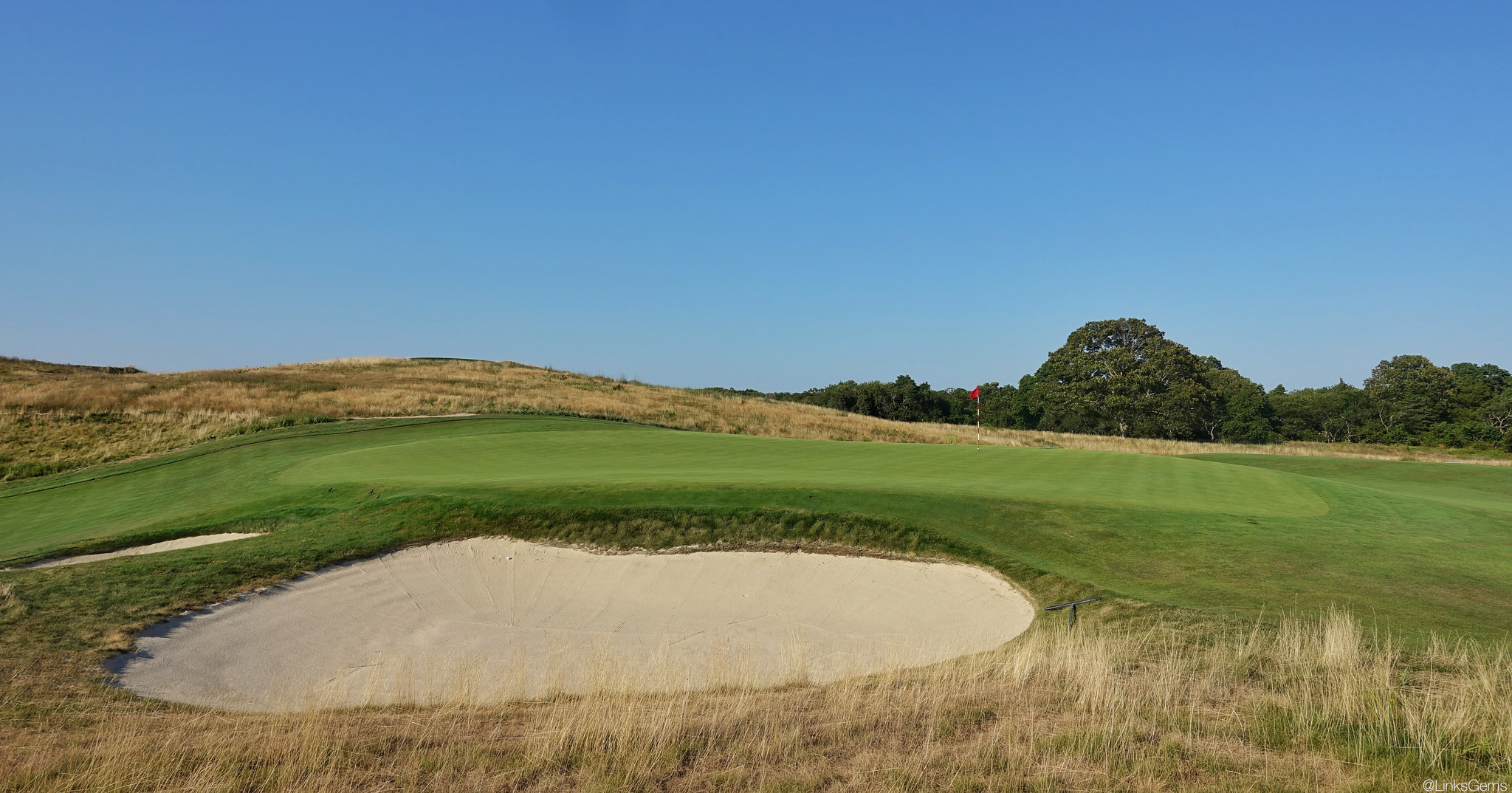I spent half the week out in the Hamptons for the U.S. Open. This year’s championship wasn’t short on controversy, so let’s get into what I liked and didn’t from Shinnecock Hills.
Like – Unpinnable green surface and short grass surrounds
To test the best players in the world, a golf course has to have the ability to separate great shots from average ones (cc: PGA Tour). Shinnecock’s green complexes shined and required the utmost thought and respect when approaching. It was because of the short grass surrounds and unpinnable edges of the green, which both repelled and corralled shots. These false fronts and fall-offs make Shinnecock’s greens appear much larger than they actually are. They eject average shots down a hill the way they should. They force careful thought about where a shot is landing, its trajectory, and spin. They strike fear in players’ minds even when they have a wedge in hand. One look at Mark Broadie’s strokes gained statistics for the week shows the importance that approach shots played at Shinnecock.

Of the top 15 players, none ranked worse than 35th in strokes gained approach. Driving it long and straight was an advantage but not a prerequisite: five of the top 15 players had a negative strokes gained off-the-tee statistic. The long-hitting Brooks Koepka won, but it wasn’t because of his driver. He ranked 32nd in SG off-the-tee. It was because of his approach play and putting, where he ranked 1st and 2nd in strokes gained. Thanks to width and the interesting green surrounds, this year’s U.S. Open was about skill, not power.
Don’t like – The thin line with course setup
The U.S. Open’s identity is rooted in being the greatest examination in golf. It’s a tournament that pushes and tests a golfer’s game to the limit. After four arduous rounds of golf at a supreme test of golf, a champion is crowned. A U.S. Open course should mercilessly test every aspect of a player’s game both physically and mentally.
The lead-up to this year’s U.S. Open focused on the infamous Sunday during the 2004 U.S. Open when the USGA lost control of Shinnecock Hills. Mike Davis vowed this year that it wouldn’t happen again…
Following his third round, Zach Johnson went into a SkySports interview and stated, “It’s pretty much gone, it’s pretty much shot.” Johnson’s comments on the conditions of the golf course were wildly inaccurate. The golf course wasn’t lost, there were just a few bad pin positions. The effects of Johnson’s interview were monumental. It sent the internet into a tizzy and altered the course of the championship. Following the third round, the USGA apologized and neutered Shinnecock Hills for the final round of the U.S. Open.
Zach Johnson seems to have made his mind up on the ‘have they lost the course’ question @NoLayingUp @TronCarterNLU pic.twitter.com/E9VkWvPMAL
— UK Golf Guy (@ukgolfguy) June 16, 2018
The USGA’s setup issue at Shinnecock stems from a much larger problem. It’s become nearly impossible to test the world’s best players because of technology. It’s the runaway train that is transforming golf from a game of skill, thought and execution into one that’s strictly execution-based. It’s not limited to low-spin, high-launch solid core balls. It includes the 460 cc driver heads that make it virtually impossible to miss. The driving irons and hybrids that effortlessly launch balls high enough to hit to tucked flags. Green reading was an art until books that tell players every slope and contour on the putting surface came along. TrackMan ties it all together, allowing players to optimize every piece of their swing. Today’s players are talented and better than ever – not because of skill but because of their tools. These innovations have actually diminished the skills that the world’s best players have in their arsenal.
Many of today’s prototypical Tour pros appeared clueless at Shinnecock thanks to changing winds, uneven lies and vexing green complexes. The idea of flighting a 4-iron into a modest wind from 180 to control the spin as opposed to bashing a 7-iron is a foreign concept. Rather than use the ground around the greens, many immediately grabbed their 60 degree and watched helplessly as chip shots rolled back to their feet. Shinnecock Hills asked a slew of questions to the world’s best players that they had never seen.
Most failed, and it’s not their fault. Their week-in and week-out setups on the PGA Tour don’t ask these difficult questions. To succeed on the PGA Tour, they don’t need these shots, so why learn how to hit them? These are the skills that the great players of yesterday had in spades. Skills they learned because they didn’t have solid core golf balls, massive driver heads and books that told them every slope on perfectly manicured greens.
The technology effect has been two-fold. It’s made it nearly impossible for the USGA to properly set up a golf course, and it has also robbed the game of skill. Combine the two together, and the line of a good setup and bad setup is razor thin. The vast majority of players lacked the ability to hit the shots that were needed at Shinnecock, and their first reaction was to complain.
Instead of introspection, the criticism was directed towards the nation’s greatest championship test and its setup. It’s a golf course that’s been lengthened nearly 800 yards since its remodeling in 1931 and sees green speeds of 12-14 as opposed to the 6-7 that it was designed for. All done in order to combat technology and the businesses that profit from it. The technology effect has reduced the line of what’s fair and unfair for the USGA to a millimeter. The USGA is in a no-win situation. Go too far and face the wrath of players, too soft and face the wrath of viewers who tune in to see a different product than the monotonous point-and-shoot game on the PGA Tour.
There is a simple solution for the USGA: control the technology, restore skill to the game and regain the ability to set up a fair test of golf. The skill and challenge is what makes golf the greatest game in the world, not the long drives.
Like – The idea of a U.S. Open rota
An issue that the USGA faced with Shinnecock was unfamiliarity. We saw vast discrepancies over the weekend with morning and afternoon tee times because the golf course dries out so well. Just like round 3, we saw more under-par scores from the morning tee times than the afternoon in round 4.
The USGA hadn’t hosted an event at the venerable Shinnecock Hills design since 2004. As much as Mike Davis hinted that agronomic technology would make it impossible to mess this one up, drama ensued.
A way to help alleviate this in the future is moving to a U.S. Open rota, akin to what the Open Championship has. It would give the USGA some continuity and the ability to learn what does and doesn’t work at different rota sites. Over the years, the setup would improve year after year.
When it comes to picking a rota, that’s a little more difficult, but here’s what I would do. I am going to assume that the ball is rolled back and some older courses become options again. I would move to a six-host rota with wild cards worked in every 3 years. Here are my six sites that are spread across the country (sorry Texas, mid-plains and southwest):
Set rota:
Shinnecock Hills (NY)
Oakmont (PA)
Pebble Beach (CA)
Pinehurst (NC)
Winged Foot (NY)
Oakland Hills – South (MI)
The wild card sites would include:
Merion (PA)
The Country Club – Brookline (MA)
LACC – North (CA)
Inverness (OH)
Riviera (CA)
Southern Hills (OK)
Prairie Dunes (KS)
Olympia Fields – North (post-restoration) (IL)
Oak Hill – East (NY)
Olympic Club (CA)
Chambers Bay (WA)
Erin Hills (WI)
Don’t like – #LiveUnderPar setups
Is there a bigger indictment of the weekly PGA Tour setups than the fact that Brooks Koepka has won back-to-back U.S. Opens and only one PGA Tour event in his career?
Brooks Koepka’s success isn’t limited to the U.S. Open. He hasn’t finished outside of the top 21 in a major since the 2015 Masters. Two years in a row at the game’s greatest test, he’s proven himself as the best player in the field. In 77 non-major PGA Tour starts, he has one win. Something seems amiss…
It points back to course setup. The USGA is criticized for crossing the line with setup occasionally, but at least they see the line. The PGA Tour’s weekly setup isn’t about testing players’ golf games. It’s about providing entertainment.
In a way, the Tour misses the mark on golf. What makes the game great is that it is hard. If it was easy, it would be boring. Golf tragics like myself wouldn’t exist if the game was simple. The complexity and challenge is what makes the game entertaining. While the USGA gets indicted for occasionally overstepping the line, the PGA Tour deserves scrutiny for never even approaching that same line. The majors want a setup for championship golf. The majors will always have more weight, and the manufactured entertainment feel you get from PGA Tour setups only widens the gap.
If the PGA Tour set up golf courses properly, Brooks Koepka would have a lot more trophies in his closet.
Like – Tommy Fleetwood

That’s two U.S. Opens in a row that Tommy Fleetwood has raised his stateside stock with marvelous play. At 27, Fleetwood has already seen the highs and lows of the game. He burst onto the scene as one of the most promising young European players before undergoing struggles with his tee-to-green game. He tumbled down to 285th in the world before rediscovering the precision that made him a can’t-miss youngster. The struggles make him endearing. He’s not a player whose road has been without adversity. He’s a player that’s becoming a star because of the adversity. It gives him perspective and an authenticity you don’t see with most players. Not in the fan club yet? Check out his interview after finishing runner-up.
Don’t like – Star treatment
The Phil Mickelson mess polarized golf fans. Some found comedy in it. I laughed a few times. Some found it a disgrace that he wasn’t DQ’d. I think he should have been.
Looking at the situation objectively, if a middling pro had done what Phil did, would he have been playing beyond the 13th green? I don’t believe he would have. Phil got some preferential treatment and he should have been DQ’d.


 by
by 
